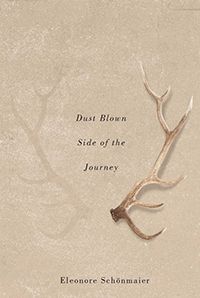Reviews
Poetry Review by Emma Skagen
Eleonore Schönmaier, Dust Blown Side of the Journey (Montreal: McGill-Queen's, 2017). Paperbound, 126 pp., $16.95.
 Eleonore Schönmaier’s fourth poetry collection, Dust Blown Side of the Journey, is the work of a poet who has mastered her craft. At once profound and provokingly plainspoken, the collection is a journey in itself. Schönmaier’s poetic landscape, featuring a beautifully elaborate intertwining of images, leaves it up to you what threads to pick out and follow.
Eleonore Schönmaier’s fourth poetry collection, Dust Blown Side of the Journey, is the work of a poet who has mastered her craft. At once profound and provokingly plainspoken, the collection is a journey in itself. Schönmaier’s poetic landscape, featuring a beautifully elaborate intertwining of images, leaves it up to you what threads to pick out and follow.
What is immediately striking about Dust Blown is that one cannot passively read the collection; from the get-go Schönmaier demands something of the attentive reader. Her epigraph, a quotation from Heraclitus, is presented in ancient Greek script with no accompanying translation. At once daunting and enticing, the quotation tempts you to search out its meaning on your own: “If you do not expect the unexpected, you will not find it; for it is hard to be sought out and difficult.” In an incredible show of intent, Schönmaier guides her reader (in Greek, no less) to read her collection with curiosity, as if sending them on a challenging quest.
With the epigraph deciphered and the first few pages flipped, I could see that Dust Blown would not be letting the reader off lightly. With no larger structure or section headings dictating overarching themes, the collection quickly shows itself to be a sort of poetic Choose-Your-Own-Adventure. The connections between poems are everywhere, but manifest quite unexpectedly, and the precise intentions behind them are not always obvious. I found that if I did not expect the unexpected, indeed—I would not find it. And perhaps this lesson in reading with heightened curiosity, searching out the unexpected for ourselves, is the heart of the so-called “dust blown side of the journey.”
So what exactly is the dust blown side of the journey, and why, for Grammar’s sake, is “dust blown” not hyphenated? Continuing my reading, I soon found that this same uncomfortable separation or scattering in the unhyphenated “dust blown” is part of the reality Schönmaier uncovers. The words “dust” and “blown” are separated, but a hyphen is arguably a weak or makeshift connector to begin with. With the title consistently reminding me of this missing connector, I found I was drawn to contemplate the way the two words create a doubling or layering of images; my mind expects to read “dust-blown,” but it also can’t help but wonder what unexpected meaning might be found reading the two words as separate entities. Like Schönmaier’s sprinkling of surprising connections between poems—the birds, the trees, the bicycles, the border-crossers, the music—her title encourages me to both form connections and consider the very act of finding meaning.
As I became acquainted with the book’s eclectic cast of recurring characters, I found that Schönmaier’s distinctive use of enjambment (as in “the dust / blown side of the / journey”) is almost always surprising. The first poem in the book, “When I Reach,” begins its striking series of enjambed lines in the poem’s title, which acts as the poem’s first line:
[When I reach]
the tunnel
exit you’ll be
there waiting for
me sitting on a wooden
crate at the side [...]
The effect, with each line adding weight to the previous one, reminds us again of Schönmaier’s epigraph: expect the unexpected. Fittingly, “When I Reach”—like many poems in the collection—does not end with a period—“I’ll give / you my hands”—leaving us to wonder what added meaning the missing next line might have held.
The crumbs of continuity Schönmaier scatters throughout the collection truly make the reading of this book a journey of discovery. These images make themselves known from the start, when the second poem, “Paradise Evacuated,” mentions the “orange in her swimsuit,” eliciting a continuity from the preceding poem’s “half broken / boards where the faded / words once said oranges.” As these connections continue from poem to poem, they begin to feel akin to recurring melodies or riffs across distinct movements of a composition.
While an orange seems a rather innocuous recurring image, others are less so. The piano in “The Morning After” carries with it a particularly poignant image: a blue paramedic’s glove on its keyboard. In the following “Risk,” the Steinway is mentioned, and later, “our / missing friend.” Further into the book, when the poems’ journeys are often to do with crossing borders and cultural lines, another repeated image shook me to the core. In “Winter Coat,” a young girl’s father makes a point by defecating on a “winter / jacket” given to her by a soldier. In the facing “Refuge,” a woman avoids a man on the train because of his “bulky jacket.” There are no easy answers as to what connections ought to be drawn from these links. And I think that’s the point—Heraclitus’s difficult unexpected. But this is certainly not to say that Dust Blown is overbearing in its demand that readers participate in the propagation of possible meanings. Schönmaier’s language is remarkably simple, and one need not work hard to find poems both captivating and moving. From explorations of intimacy, vulnerability, and solitude, to provocative studies of art and cultural difference, the journeys offered are replete with ideas and feeling.
—Emma Skagen









